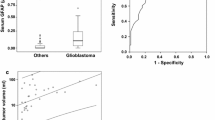Abstract
Objective: To determine if serum S-100β levels are elevated in children with brain neoplasms and if it can be used as a tumor marker for children with brain neoplasms.
Design: Prospective cohort study.
Setting: Urban, tertiary care, children's teaching hospital.
Patients: 136 healthy children and 27 children with brain neoplasms.
Methods: Serum levels of S-100β were measured in 136 healthy children to serve as controls and 27 children with brain neoplasms, who underwent biopsy or resection of the mass. Patients were then classified into astrocytoma or non-astrocytoma groups.
Measurements and main results: The median serum S-100β level for the control group was 0.27 mcg/l (range, 0.06–2.6 mcg/l), and for the brain neoplasm group was 0.2 mcg/l (range, 0.01–2.1 mcg/l), (p = 0.09). There were 13 children with astrocytomas and 14 with non-astrocytomas. The S-100β levels for the astrocytoma group was 0.25 mcg/l (range, 0.05–1.1 mcg/l) and for the non-astrocytoma group 0.17 mcg/l (range, 0.01–2.1 mcg/l), (p = 0.47).
Conclusions: Serum S-100β levels are not elevated in children with brain neoplasms compared to healthy children, nor are they elevated in children with astrocytomas compared to non-astrocytomas. The S-100β protein does not appear to be useful as a serum tumor marker in children with brain neoplasms.
Similar content being viewed by others
References
Ghanem G, Loir B, Morandini R, Sales F, Lienard D, Eggermont A, Lejeune F: On the release and half-life of S-100β protein in the peripheral blood of melanoma patients. Int J Cancer 94(4): 586–590, 2001
Heizmann CW, Fritz G, Schafer BW: S-100 proteins: structure, functions, and pathology. Front Biosci. 7: 1356–1368, 2002
Gazzolo D, Bruschettini M, Lituania M, Serra G, Bonacci W, Michetti F: Increased urinary S-100β protein as an early indicator of intraventricular hemorrhage in preterm infants: correlation with the grade of hemorrhage. Clin Chem 47: 1836–1838, 2001
Donato R: S-100: a multigenic family of calcium-modulated proteins of the EF-hand type with intracellular and extracellular functional roles. Int J Biochem Cell Biol 33: 637–668, 2001
Kaskel P, Berking C, Sander S, Volkenandt M, Peter RU, Krahn G: S-100 protein in peripheral blood: a marker for melanoma metastases. J Am Acad Dermatol 41(6): 962–969, 1999
Henze G, Dummer R, Joller-Jemelka HI, Boni R, Burg G: Serum S100 — A marker for disease monitoring in metastatic melanoma. Dermatology 194: 208–212, 1997
Spinella PC, Dominguez TD, Drott HR, Huh J, McCormick L, Rajendra A, Argon J, McIntosh T, Helfaer M: S-100β protein — Serum levels in healthy children and its association with outcome in pediatric traumatic brain injury. Crit Care Med 31(3): 939–945, 2003
Rothoerl RD, Woertgen C, Holzschuh M, Metz C, Brawanski A: S-100 serum levels after minor and major head injury. J Trauma 45(4): 765–767, 1998
Raabe A, Grolms C, Sorge O, Zimmerman M, Seifert V: Serum S-100β protein in severe head injury. Neurosurgery 45(3): 477–483, 1999
Woertgen C, Rothoerl RD, Holzschuh M, Metz C, Brawanski A: Comparison of serial S-100 and NSE serum measurements after severe head injury. Acta Neurochir 139: 1161–1165, 1997
Missler U, Wiesmann M, Friedrich C, Kaps M: S-100 protein and neuron-specific enolase concentrations in blood as indicators of infarction volume and prognosis in acute ischemic stroke. Stroke 28: 1956–1960, 1997
Lindberg L, Olsson A-K, Anderson K, Jogi P: Serum S-100 protein levels after pediatric cardiac operations: a possible new marker for postperfusion cerebral injury. J Thorac Cardiovasc Surg 116(2): 281–285, 1998
Rosen H, Rosengren L, Herlitz J, Blomstrand C: Increased serum levels of the S-100 protein are associated with hypoxic brain damage after cardiac arrest. Stroke 29: 473–477, 1998
Bottiger BW, Mobes S, Glatzer R, Bauer H, Gries A, Bartsch P, Motsch J, Martin E: Astroglial protein S-100 is an early and sensitive marker of hypoxic brain damage and outcome after cardiac arrest in humans. Circulation 103: 2694–2698, 2001
Missler U, Wandinger KP, Wiesmann M, Kaps M, Wessel K: Acute exacerbation of multiple sclerosis increases plasma levels of S-100 protein. Acta Neurol Scand 96(3): 142–144, 1997
Bartosik-Psujek H, Stelmasiak Z: Biochemical markers of damage of the central nervous system in multiple sclerosis. Ann Univ Mariae Curie Sklodowska 56: 389–392, 2001
Infante JR, Torres-Avisbal M, Martinez A, Vallejo JA, Aguilera C, Contreras P, Benitez A, Latre JM: Evaluation of tumor marker S-100 in cerebrospinal fluid from subjects with nonischemic brain pathologies. Tumour Biol 21: 38–45, 2000
de Vries J, Thijssem WAMH, Snels SEA, Menovsky T, Peer NGM, Lamers KJB: Intraoperative values of S-100 protein, myelin basic protein, lactate, and albumin in the CSF and serum of neurosurgical patients. J Neurol Neurosurg Psychiatry 71: 671–674, 2001
Kapural M, Krizanac-Bengez Lj, Barnett G, Perl J, Masaryk T, Apollo D, Rasmussen P, Mayberg MR, Janigro D: Serum S-100β as a possible marker of blood-brain barrier disruption. Brain Res 940: 102–104, 2002
Rowland LP, ed. Merritt's Neurology. Lippincott Williams & Wilkins, Philadelphia, PA, 2000, p 302
Petty MA, Lo EH: Junctional complexes of the blood-brain barrier: permeability changes in neuroinflammation. Prog Neurobiol 68(5): 311–323, 2002
Perry VH, Anthony DC, Bolton SJ, Brown HC: The blood-brain barrier and the inflammatory response. Mol Med Today 3: 335–341, 1997
Gardenfors A, Nilsson F, Skagerberg G, Ungerstedt U, Nordstrom CH: Cerebral physiological and biochemical changes during vasogenic brain oedema induced by intrathecal injection of bacterial lipopolysaccharides in piglets. Acta Neurochir 144: 601–608; discussion 608–609, 2002
Reiber H: Dynamics of brain-deprived proteins in cerebrospinal fluid. Clin Chim Acta 310: 173–186, 2001
Author information
Authors and Affiliations
Rights and permissions
About this article
Cite this article
Rajendra, A., Spinella, P.C., Drott, H.R. et al. S-100β Protein – Serum Levels in Children with Brain Neoplasms and its Potential as a Tumor Marker. J Neurooncol 67, 345–349 (2004). https://doi.org/10.1023/B:NEON.0000024216.15923.77
Issue Date:
DOI: https://doi.org/10.1023/B:NEON.0000024216.15923.77




